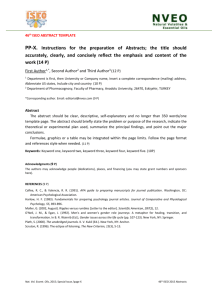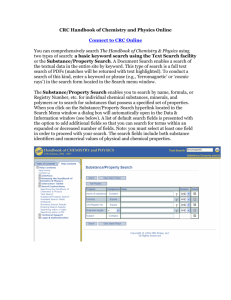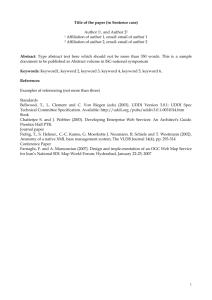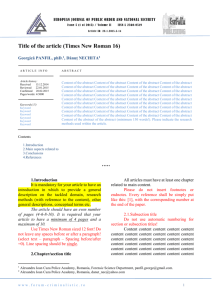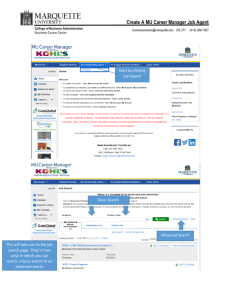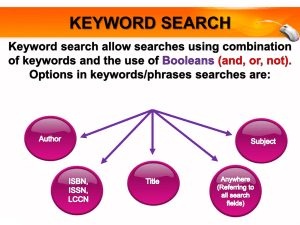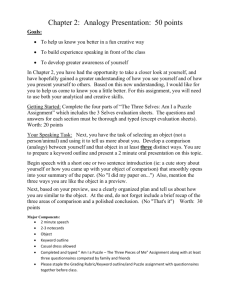Adapting Textbook and Activities in Science
advertisement
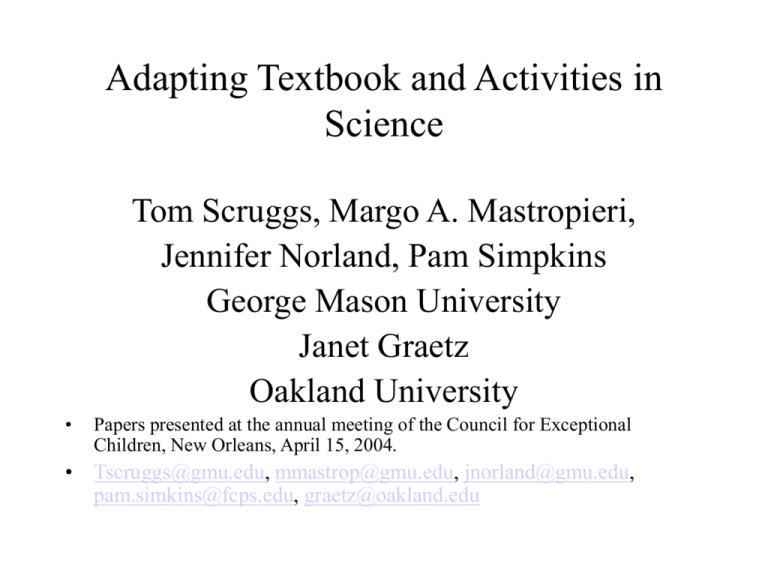
Adapting Textbook and Activities in Science Tom Scruggs, Margo A. Mastropieri, Jennifer Norland, Pam Simpkins George Mason University Janet Graetz Oakland University • Papers presented at the annual meeting of the Council for Exceptional Children, New Orleans, April 15, 2004. • Tscruggs@gmu.edu, mmastrop@gmu.edu, jnorland@gmu.edu, pam.simkins@fcps.edu, graetz@oakland.edu Approaches to Science Instruction Textbook • high language demands • high literacy demands • substantial vocabulary • abstract content • high factual learning demands • factual recall on tests Activities-oriented • reduced language • reduced literacy • reduced vocabulary • hands-on experiences & “enactments” • minimal testing • performance-based testing Textbook Challenges • Increase in difficulty with grade level • Discrepancy between reading level of students and readability of textbooks (Kinder, Bursuck & Epstein, 1992) • Breadth vs Depth of Coverage • Unfriendly nature of textbooks (Armbruster & Anderson,1988) • Introduction of large number of vocabulary words (Yager, 1983) Secondary Science • Typical instructional formats – – – – – – Lecture to entire class with discussion Lab activities with partners Rapid pace of teacher presentations Rapid pace through textbook One class period for lab work Tests and quizzes administered on chapter by chapter and unit basis linked to high stakes state wide tests Effective Instruction • Maximized student engagement • Direct questioning directly relevant to objectives • High rate of responding • Step-by-step instruction • Frequent monitoring of learner progress toward meeting prespecified objectives (House et al., 1978; Rosenshine & Stevens, 1986) PASS Variables • Prioritize Objectives • Adapt materials, environment, and instruction • SCREAM variables – structure, clarity, redundancy, enthusiasm, appropriate rate, maximize engagement • Systematic evaluation Strategies for Adapting Textbook Approaches to Science Learning • Textbook Selection • Mnemonic strategies – IT FITS Strategy • Text-processing strategies – – – – – Powerpoint Framed Outlines Spatial Organizers TRAVEL strategy Text structure processing • Classwide wide peer tutoring Criteria for Selecting Textbooks Did I ... • Consider adequacy of content coverage? • Evaluate – – – – – – – – readability text structure text coherence instructional strategies assessment procedures attractiveness supplemental materials practice activities? The Keyword Strategy • Helpful for learning science vocabulary • Steps in using the keyword method: – Recode unfamiliar word to an acoustically similar but familiar word or keyword. – Relate the the keyword in an interactive picture with the to-be-remembered information – Retrieve the new definition by thinking of the keyword and what was happening in the interactive picture IT FITS Strategy* Identify the term Tell the definition of the term Find a keyword Imagine the definition doing something with the keyword Think about the definition doing something with the keyword Study what you imagined until you know the definition *King-Sears, M.E., Mercer, C.D., & Sindelar, P.T. (1992). Toward independence with keyword mnemonics: A strategy for science vocabulary instruction. Remedial and Special Education, 13, 22-33. PowerPoint Presentations • • • • • • • Help focus attention Reinforce vocabulary, important points Highlight concepts and relationships Add colors, pictures, animation and/or sound Interactive, requires student responses Highlight steps in activities Students can create their own PowerPoint presentations Graphic Organizers • Inspiration or Kidspiration software – Down load free 30 version at inspiration.com • Draw with crayons • Use Power point or other software Main Idea Strategy 1. What are you studying the passage for? 2. Find the main idea in the paragraph and underline it/them. 3. Think of a question about the main idea you have underlined. 4. Learn the answer to your question. 5. Always look back at the questions and answers Sample Summarization Strategy (Malone & Mastropieri) • • • Read the paragraph - ask and answer: – – Who or what is it about? What is happening to them? – tells what the whole paragraph is about Use those answers to write a summary sentence Use self-monitoring card Text-Structure Based Strategies • Main idea strategy (find & underline, write down, & study information) • List strategy (find & underline topic of passage, write down topic/subtopic, study information) • Order strategy sequential (find & underline main topic, write down what was different for each step in passage, study information) Highlighting Self-Monitoring Did I examine my book for boldfaced print, types of subheadings, charts, maps, or figures? Did I find important information by asking and answering questions: -is it new information? -is it a new concept? -is it a new vocabulary word? -does it describe important people or events? -does it list causes of events or things? -is it a main idea? -does it compare and contrast things? -did my teacher emphasize it? Did I select information to be highlighted? Did I highlight it? Did I test myself on the highlighted information by asking and answering questions about the highlighted information? Did I reward myself for good strategy use? Tutoring Condition Materials • Rules and Procedures for Tutoring • Folders containing strategy sheets – What is … – A strategy to help you remember – What else is important about . ? – What is an example of --- ? • Student recording sheets Scientific Process Skills – – – – – – Observing, Classifying Predicting Comparing Contrasting Charting, Graphing, Recording Data Various Science Activities • • • • • • • • • • Measuring and pouring Mapping Invention and discovery Kits and models Human anatomy Plants and animals Astronomy Force and motion Physics of sound Solids, liquids, gases • Microscopes • Powders, mixtures and solutions • Weather • Water activities • Rocks, minerals and fossils • Earth science, landforms • Magnetism and electricity • Light and color Problem Solving • Very structured and guided instruction • Build ecosystem and observe plant, animal growth & interactions with environment • Predict effects of acid rain, too much salt, too much fertilizer on your ecocolumn • PORC = predict, observe, record, compare • Minimal insight required for success • Disability specific adaptations made Disability-Specific Adaptations • • • • Vocabulary check-sheets Modified worksheets Communication boards Teacher and peer assistance with reading tasks • Special matching of peers in small groups • Testing adaptations - oral and transcribed Adapt, but Increase Interest • • • • • • Concrete lessons Meaningful lessons Hands-on materials Illustrations Discrepant events Use novelty to involve students Summary • Tension exists between demands of high stakes testing and teaching students with disabilities in inclusive classes • A variety of evidence-based techniques have improved performance – Extend interaction and practice with text • Text adaptations – Use strategies with peer tutors – Enhance meaningfulness and concreteness – Use activities to enhance meaningfulness • Adapt activities to ensure success

